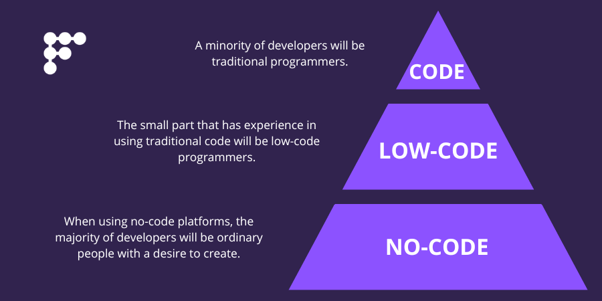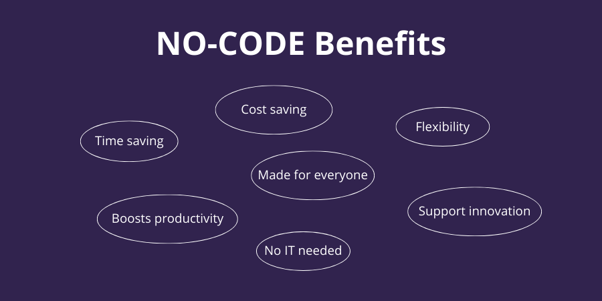This article takes an in-depth look at how no-code platforms are gradually becoming the heroes of digital transformation, offering a new paradigm for rapid, user-friendly and effective digital change.
Content
The Rise of No-Code in the Digital World
Why No-Code Is Essential for Digital Transofmation?
Real Exmples of No-Code in Practice
Potencial Difficulties and Challenges
Introduction
In today's modern business world, the term "digital transformation" has become synonymous with progress, innovation and adaptation. It means incorporating digital technologies into all aspects of the business to create value, streamline operations and ensure relevance.
As companies race against time to adapt and innovate, finding tools and technologies that offer agility and speed becomes the number one topic.
No-code platforms are coming into play - tools that are not only changing the way software developers look at things, but also redefining the way companies approach digital transformation. They bridge the technical gap, democratize development, and allow companies to remain flexible in this environment.
What Is No-Code?
Simply put, no-code is a method of creating digital tools - apps, websites and software - without having to write a single line of traditional code. Instead of complex programming languages, users use a visual interface in which they create functional products by simply dragging and dropping elements. Read more about the basics of no-code in our article.
How does no-code differ from its counterpart, low-code? Although both systems promote the idea of simplified software development, low-code platforms still require some knowledge of coding. They provide developers with shortcuts and pre-made components, but you need to know how to code to fill in the gaps. On the other hand, no-code platforms are very intuitive and are designed to be used by individuals regardless of their technical skills.
The implications of this difference are very significant. The traditional way of developing software, which involves complicated code and lengthy development processes, has barriers that can put many people off. Low-code tools have tried to at least partially remove these barriers, and finally no-code tries to break them down completely. They encourage the democratisation of the digital environment, where creation is not just the prerogative of a few people with technical know-how, but rightfully available to anyone with an idea.
What will this situation look like in the coming years?

The Rise of No-Code in the Digital World
In the last few years, a so-called silent revolution has taken place in the digital sphere. Amidst the hype around artificial intelligence, virtual reality and IoT, no-code platforms have subtly started to make their way into the mainstream.
What is their main promise? To democratise the art of digital creation and make it accessible to all.
Historically, software development has been a very difficult process, reserved only for those with specialized programming skills.
However, as digital technologies have evolved, there has also been an urgent demand for tools that would allow companies to adapt quickly to changing technological conditions without always having to rely on a full IT team. This gap has been filled by no-code platforms that offer agility, simplicity and shorter time to market.
The potential of no-code has been realised by a range of industries from e-commerce to healthcare.
However, no-code has not benefited the most from startups, which are typically characterized by the need for rapid prototyping and scalability. However, established companies have also started to use no-code, especially to innovate without the bureaucracy and unnecessary delays associated with conventional development practices.
Investment in no-code and low-code tools in the millions of dollars over the past few years:
%20(1).png?width=589&height=295&name=(mil.%20$)%20(1).png)
More information can be found here.
Why No-Code Is Essential for Digital Transformation
In an effort to stay competitive, digital transformation has become an absolute necessity for businesses around the world. In this environment, no-code platforms are emerging as game-changing players, and here's why:
- Speed: Traditional software development often involves long cycles - from requirements gathering to implementation. No-code platforms shorten this cycle significantly, allowing companies to launch applications in a fraction of the usual time. With this speed, companies can respond to market changes in real time.
- Low Cost: Development costs are not just about the initial build, but also include maintenance, updates and any bug fixes. By eliminating the need for large development teams and reducing the complexity of updates, no-code platforms offer significant cost savings in the long run.
- Scalability: digital transformation is a long journey, not a one-off project. As companies grow and evolve, their digital tools must scale accordingly. No-code platforms are built on scalability and allow for tweaks and adjustments without always having to start from scratch.
- Supporting "non-technical" Teams: in the past, creating digital tools was the prerogative of the IT department. With no-code, this approach is changing. Marketing, HR or sales departments can now create digital products tailored to their specific needs. This democratization not only speeds up processes, but also fosters a culture of innovation throughout the organization.

Real Examples of No-Code in Practice
The theoretical benefits of no-code platforms may seem impressive, but real-world applications really highlight their potential. Here are some notable examples that show the tangible impact of no-code on businesses:
1. Dividend Financing through Bubble:
.png?width=450&height=225&name=N%C3%A1vrh%20bez%20n%C3%A1zvu%20(40).png)
Dividend Finance wanted a robust platform to manage solar and home financing. Using Bubble, they created a comprehensive digital solution tailored to their exact needs. This not only streamlined their operations, but also improved the user experience, showing how no-code can revolutionize industry-specific requirements.
You can read more about their success here.
2. HelloSign's Switch to Webflow:
.png?width=450&height=225&name=N%C3%A1vrh%20bez%20n%C3%A1zvu%20(41).png)
HelloSign, an e-signature platform, faced issues with the design and functionality of its blog. By adopting Webflow, they changed the design of their blog, which led to an optimized publishing process and a surge in content creation. Their experience underscores the flexibility of no-code tools in improving the digital content platform.
More similar case studies can be found here.
3. Reaching Patients in Solis Mammography via AppSheet:
.png?width=450&height=225&name=N%C3%A1vrh%20bez%20n%C3%A1zvu%20(42).png)
The healthcare sector's demand for effective digital solutions continues to grow. Identifying this need, Solis Mammography used AppSheet to create a custom app designed to reach patients. This platform has transformed their appointment management and follow-up system and has demonstrated how no-code can be used to achieve significant operational improvements in critical industries.
You can read how else AppSheet can be used here.
The Future of No-Code
- Increasing democratisation: as no-code platforms continue to evolve, they will become even more user-friendly and versatile, allowing more people from different disciplines to create new digital solutions. We will see innovation coming not only from a few tech giants, but also from a decentralised ecosystem where anyone can become an innovator.
- Integration with Modern Technologies: No-code platforms can already be integrated with artificial intelligence, machine learning and IoT. In the future, for example, even the creation of apps can be driven by AI, using only a drag and drop editor.
- Sustainability and Scalability: as today's businesses are constantly evolving, no-code platforms will prioritize sustainable growth in the future. This means creating platforms that not only serve current needs, but can also seamlessly adapt to future requirements without the need for redesign.
- Personalisation Instead of One-Size-Fits-All Products: while many of today's tools offer one-size-fits-all solutions, the future lies in hyper-personalised applications. No-code will allow companies to build solutions tailored to their unique challenges and customer needs.
- Potential replacement for traditional no-code coding: No-code platforms have revolutionized digital development and made app creation accessible to many people. However, they do not replace traditional coding. Instead, they complement each other. While no-code meets general digital needs, traditional coding solves complex, specialized tasks.
Potential Difficulties and Challenges
Although the benefits of no-code platforms are manifold, it is important to be aware of their potential shortcomings:
- Complexity Cap: No-code solutions are ideal for many types of use cases, but may not suit highly complex projects with specific technical requirements or custom features.
- Fixation on a Provider: Being tied to a platform's ecosystem can be a problem, especially if the platform undergoes changes, increases in price, or is discontinued.
- Performance Issues: Applications developed using no-code tools may not always be as optimized as those developed in the traditional way, which can lead to slower loading times or lower performance.
- Security Concerns: Relying on third-party platforms can raise issues around data security, compliance and control.
As usual, however, while there are some difficulties and challenges, they are not insurmountable. A proactive and informed approach can turn potential pitfalls into manageable obstacles and ensure that the benefits of no-code are fully and effectively leveraged.
Conclusion
The digital environment is constantly evolving and it is important that businesses are constantly looking for agile and innovative solutions to help them stay competitive. No-code platforms have become a major player in this area, promising to democratize application development and digital transformation. They enable individuals and companies to quickly turn ideas into tangible digital products without having to overcome the barriers associated with programming expertise.
The future outlined by the rise of no-code looks promising. On current trends, we are embarking on the next journey of this digital age, where the opportunity to engage, innovate and transform for all will not only redefine business itself, but also reshape social interactions and structures. Adopting no-code is not just about technological advancement, but about ushering in a new era of inclusive digital empowerment.
And if you're wondering what the most popular no-code tools can help your business, check out our article on Simplify Your Marketing: Popular No-code Tools.
FAQ
1. What is a no-code platform?
Software that allows users to create applications, websites, graphics, etc. using visual interfaces without traditional coding.
2. Who can use no-code platforms?
Anyone, especially those with no coding experience.
3. Are no-code platforms safe?
The most well-known ones emphasize security; always choose platforms with a strong security reputation.
4. Difference between no-code and low-code platforms?
No-code is completely automated; low-code may require programming knowledge.
5. Will no-code replace traditional coding?
No. They complement each other, not replace each other.
6. Are no-code platforms cost-effective?
Yes. However, long-term costs vary depending on scalability and features.